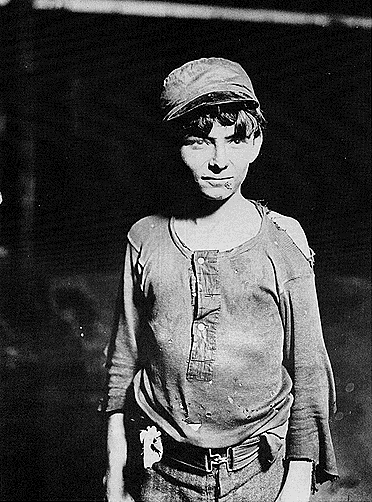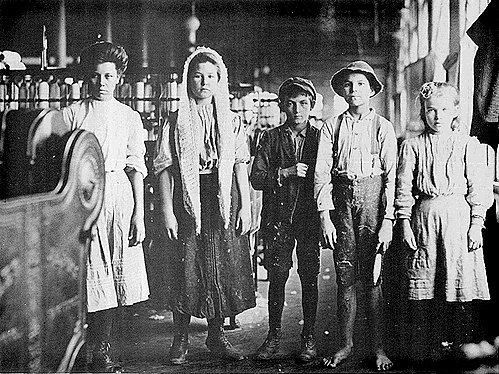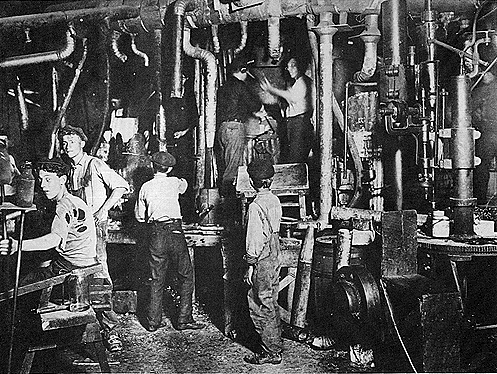Three Photographs of Children at Work, Circa 1908
The growth of industry after the Civil War increased the demand for workers and pulled more and more children into the labor force. In the twenty years between the census reports of 1890 and 1910, the number of working children between the ages of 10 and 15 rose from 1.5 million to 2 million. By 1910, children made up 18.4 percent of the total labor force.
In the National Child Labor Committee, a public interest group that started in New York City in 1904, opposition to child labor found a strong voice. The NCLC began its investigations with child labor conditions in coal mines, capitalizing on the public concern raised during the nationwide coal miners’ strike of 1902. Later NCLC investigations centered upon the glassmaking industry, textile mills—especially in the South—and the canning industry.
Eyewitness accounts of the kind of working conditions of child laborers that the NCLC was investigating and publicizing at the beginning of the 20th century appear in Children and Youth in America, Volume II, Robert H. Bremner, editor (Harvard University Press, 1971). One such account, taken from John Spargo’s The Bitter Cry of the Children (New York, 1906), describes conditions in a glass factory:
I shall never forget my first visit to a glass factory at night...the boys employed, about forty in number, at least ten of whom were less than twelve years of age. It was a cheap bottle factory, and the proportion of boys to men was larger than is usual in the higher grades of manufacture. The hours of labor for the "night shift" were from 5:30 pm to 3:30 am....Then began the work of the "carrying-in boys," sometimes called "carrier pigeons," [who] took the red-hot bottles from the benches, three or four at a time, upon big asbestos shovels to the annealing oven....The work of these "carrying-in boys," several of whom were less than twelve years old, was by far the hardest of all. They were kept on a slow run all the time from the benches to the annealing oven...was one hundred feet, and the boys made seventy-two trips per hour, making the distance traveled in eight hours nearly twenty-two miles. Over half of this distance the boys were carrying their hot loads to the oven. The pay of these boys varies from sixty cents to a dollar for eight hours’ work.
Another account, taken from Al Priddy’s Through the Mill (Norwood, Massachusetts, 1911), describes conditions in a cotton mill:
The mule-room atmosphere was kept at from eighty-five to ninety degrees of heat. The hardwood floor burned my bare feet. I had to gasp quick, short gasps to get air into my lungs at all. My face seemed swathed in continual fire…. Oil and hot grease dripped down behind the mules, sometimes falling on my scalp or making yellow splotches on my overalls or feet. Under the excessive heat my body was like a softsponge in the fingers of a giant; perspiration oozed from me until it seemed inevitable that I should melt away at last. To open a window was a great crime, as the cotton fiber was so sensitive m wand that it would spoil…. When the mill was working, the air in the mule-room was filled with a swirling, almost invisible cloud of lint, which settled on floor, machinery, and employees, as snow falls in winter. I breathed it down my nostrils ten and a half hours a day; it worked into my hair, and was gulped down my throat. This lint was laden with dust, dust of every conceivable sort, and not friendly at all to lungs.

In 1908 the NCLC hired Lewis W. Hine to investigate and to photograph the conditions of working children. The three photos that appear here are typical of the scenes that Hine captured with his camera. These photographs, numbered 102-LH-90, 102-LH-120, and 102-LH-348, are now in Records of the Children’s Bureau, Record Group 102. (See pp. 106, 108, 109.)
The results of the NCLC investigations did not build immediate or widespread public support. The most vocal opponents included southern mill owners, supporters of States rights, laissez-faire economists, and, most significant politically and morally, President Woodrow Wilson. Nevertheless, the diligent work of the members of the NCLC resulted in the establishment of the Children’s Bureau (1912), a federal information clearinghouse, and, in 1916, in the passage of the Keating-Owen Bill. The resulting law established child labor standards: a minimum age of 14 for workers in manufacturing and 16 for workers in mining, a maximum workday of 8 hours, prohibition of night work for workers less than 16, and documentary proof of age.
Today the Fair Labor Standards Act, passed in 1938, establishes minimum wages, overtime pay, and child labor standards for workers in the United States. The child labor provisions ensure children’s educational opportunities and protect their health. With the establishment of strictly enforced compulsory state education laws, full-time work for children became a thing of the past. Part-time hours vary according to hazards in the workplace. The minimum age for children employed in agriculture is 12 years, and in industry it is 14 years.
Teaching Activities
Display the photographs on the bulletin board before making assignments, and direct students to examine them closely. Remind students that Hine’s photographs were used by the NCLC to arouse public interest in and concern for the plight of working children. As when they work with all documents, students should consider the point of view of the photographer as they draw conclusions from the photographs. Student assignments should directly reflect the evidence found in these photographs.
1. Direct students to select one child portrayed in the photographs. Read to them the two eyewitness accounts of working conditions at the beginning of the 20th century. Ask students to complete one of the following writing assignments from the perspective of the child laborer in the selected photograph:
a. A diary entry that describes in detail why you are working.
b. A letter to a friend that describes in detail your daily routine at your job.
c. A diary entry that describes why you like or dislike your job.
d. Your comments to the NCLC staff that is investigating conditions in your place of work.
2. Conduct a class discussion of the following question: What role should the government assume in protecting workers—especially children—from the hazards of the workplace?
3. Make a survey of students who are employed, in order to collect such information about their jobs as wage rates, hours, and safety precautions. Ask working studentsthe following questions:


a. Did your employer advise you about hours or safety laws that protect you as a minor?
b. What procedures are required of you by the Federal and State governments before you can work?
c. Do you think that government regulations for employed minors provide you with adequate protection? or too much? or too little? Why?